 In his wonderful new book, Mars in the Movies: A History, former NASA employee Thomas Kent Miller takes us on every cinematic journey to the red planet, film by film, from the silents to today. And now, for a Flick Attack Guest List, the author takes us on a cinematic journey of a different kind: through the photos and illustrations that you won’t find in the finished book! Its loss is our gain. Time to blast off!
In his wonderful new book, Mars in the Movies: A History, former NASA employee Thomas Kent Miller takes us on every cinematic journey to the red planet, film by film, from the silents to today. And now, for a Flick Attack Guest List, the author takes us on a cinematic journey of a different kind: through the photos and illustrations that you won’t find in the finished book! Its loss is our gain. Time to blast off!
A printed book is a most finite object. It has a beginning, middle and end not only in terms of its size, content and page count. It also has strict limitations in time; books have production schedules with merciless restrictions of all sorts, especially deadlines. I turned in 69 graphics with my manuscript, and 43 glorious images were used. Those that “didn’t make the cut” were rejected mainly due to resolution issues. I’m sharing here 13 pieces of art that I mourn didn’t get into the book. These are presented in chronological order.
1. From the 1918 Danish film A Trip to Mars (Das Himmelskibet), this is the spaceship Excelsior, in which adventurer Avanti Planetarios and his crew spend six months cruising to the Red Planet. As far as I can tell, this is the first Mars “rocketship” in the cinema.

2. In a Fantascene article, Academy Award-winning special-effects expert Robert Skotak describes this astonishing otherworldly image from Rocketship X-M (1950): “[Jack] Rabin combined a hard-line matte of the foreground pinnacle with live-action scenes of the spacemen filmed at Palm Springs. He blended [Irving] Block’s painting of nuclear blasted buildings with the actual real-life terrain by means of a softline type matte.” Courtesy Wade Williams Distribution.
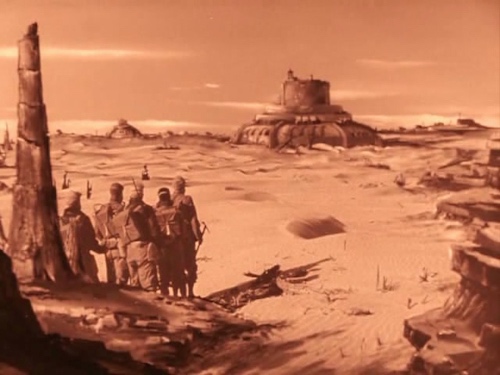
3. Eagle-Lion’s publicity department did a grand job of promoting 1950’s Destination Moon in general family magazines. Life ran a high-profile, multipage feature article about the making of the movie. Naturally, this amped up public awareness and anticipation considerably. It was this successful promotion (which reached numerous other magazines as well) that grabbed Robert Lippert’s attention, prompting him to make the ultra-cheap, 18-day “quickie” Rocketship X-M, which beat Destination Moon to the theaters by a month.
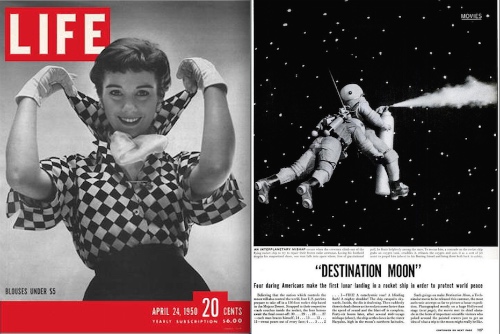
4. This is the beautiful song sheet of a tune tremendously popular in 1901; clearly part of the Mars-mania that circled the globe at the time! I could not include it in the book because it is not a movie!
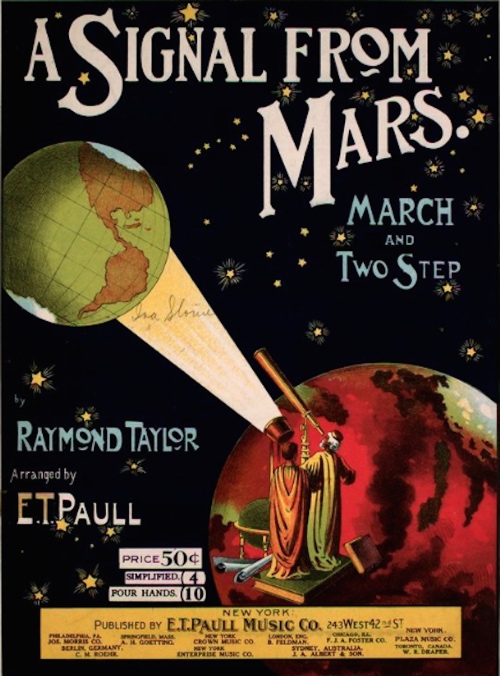
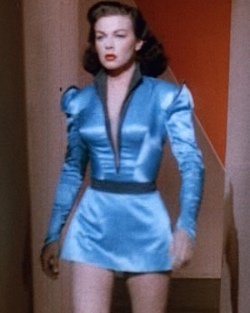 5. In Flight to Mars (1951), Marguerite Chapman plays Martian scientist Alita. When the film was released, many kids were sorely disappointed that the Martians were just humans in Destination Moon spacesuits. Yet, accepting the Martians as humans on faith really does provide rewards that are boundless. Without that notion of humanness firmly in place, it would have been impossible to justify the numerous dazzlingly gorgeous young women with perfect posture purposely gliding around the halls of the underground cities in high heels and micro-miniskirts (so short that they make Anne Francis’ skirt in Forbidden Planet seem like an evening gown). But here I must give credit where credit is due. Despite her revealing costume and Jim Barker’s double take and confusion when meeting his new (female) assistant for the first time, Chapman’s Alita is never condescended to and from the start works as an equal partner with her Martian colleagues and the earth’s male crew members. This is in vast contrast to Virginia Huston’s Carol Stafford, who comes across as the poster child for America’s cultural view that women are overemotional, second-class citizens, fit only for cooking meals and serving coffee. Courtesy Wade Williams Distribution.
5. In Flight to Mars (1951), Marguerite Chapman plays Martian scientist Alita. When the film was released, many kids were sorely disappointed that the Martians were just humans in Destination Moon spacesuits. Yet, accepting the Martians as humans on faith really does provide rewards that are boundless. Without that notion of humanness firmly in place, it would have been impossible to justify the numerous dazzlingly gorgeous young women with perfect posture purposely gliding around the halls of the underground cities in high heels and micro-miniskirts (so short that they make Anne Francis’ skirt in Forbidden Planet seem like an evening gown). But here I must give credit where credit is due. Despite her revealing costume and Jim Barker’s double take and confusion when meeting his new (female) assistant for the first time, Chapman’s Alita is never condescended to and from the start works as an equal partner with her Martian colleagues and the earth’s male crew members. This is in vast contrast to Virginia Huston’s Carol Stafford, who comes across as the poster child for America’s cultural view that women are overemotional, second-class citizens, fit only for cooking meals and serving coffee. Courtesy Wade Williams Distribution.
6. Also from Flight to Mars (1951), this is the damaged earth ship undergoing repairs on Mars. The entire image is a magnificent matte painting by Irving Block, except at the very bottom where there are several live-action people soft-matted into the work. Courtesy Wade Williams Distribution.
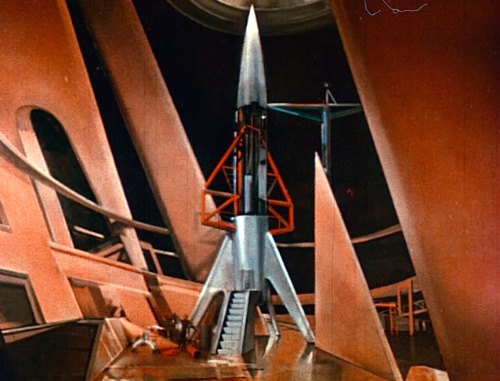
7. Appearing uncredited, Paul Frees, the prolific voice actor of the 1950s, ’60s and ’70s, plays scientist Dr. Vorhees in The Thing from Another World (1951). It is he who speaks two iconic lines. At top, Vorhees tries to file material from the spacecraft’s airfoil and announces that it is like nothing he has ever seen before. At bottom, when the team spreads out to determine the size and shape of the craft, it is Frees who exclaims, “It’s round!,” thereby being the first to articulate that the unknown craft was indeed a flying saucer.
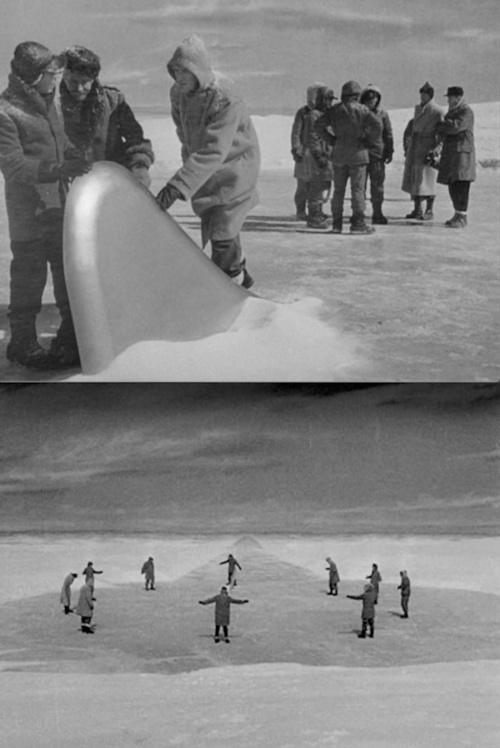
Special photo juxtapositions by Thomas Kent Miller; copyright © 2016-2017 by Thomas Kent Miller.
8. Like The Day the Earth Stood Still (1951) provides a protagonist clearly analogous to Jesus Christ, it may be that one or more of the makers of Devil Girl from Mars (1954), consciously or not, made the Martian woman Nyah the polar opposite of the Virgin Mary. Nearly every image of Mary shows her wearing a scarf covering her head, but Nyah wears a shiny black skullcap. Mary is kind, soft and modest. Nyah is cruel, hard and flamboyant. Where Mary promotes faith, love and compassion, Nyah prefers disintegrating poor specimens, kidnapping, and the destruction of the innocent. Nyah image courtesy Wade Williams Distribution.

Special photo juxtapositions by Thomas Kent Miller; copyright © 2016-2017 by Thomas Kent Miller.
9. It! The Terror from Beyond Space (1958) opens with a detailed diorama Mars-scape. The first thing the audience sees is a wide, well-crafted, black-and-white model Mars-scape with a destroyed spaceship in the middle foreground. The sky is full of stars, including a spiral galaxy. While it is impossible to see such a sight from Mars, it is still a charming image. Then the title races out from the center of the screen in mock 3-D, and the credits roll over this Mars-scape. But as soon as “Directed by Edward L. Cahn” fades from sight, the camera pans right and finally we see a second and brand- new spacecraft also in the foreground. So I have snapped images of the opening Mars-scape (before the titles roll) and the closing Mars-scape (after the titles finish) and digitally stitched them together to create a widescreen photo of the whole Mars diorama (bottom) that does not exist in the picture. Frankly, I find the image pretty breathtaking.
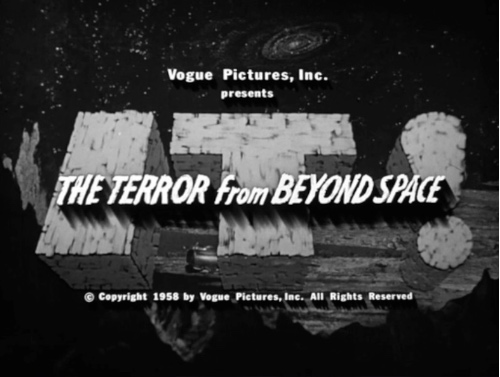
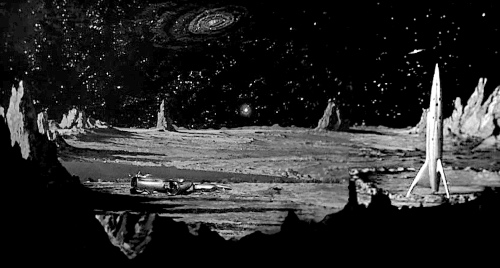
Special photo juxtapositions by Thomas Kent Miller; copyright © 2016-2017 by Thomas Kent Miller.
10. The Day Mars Invaded Earth (1963) is amazingly prescient in regard to its concept of a tiny Mars rover. The rover of the movie (at left) was filmed and included in the movie in 1962 or 1963. Yet in 1988, the Mars rovers the author saw being tested were the size of Chevy Suburbans. The small rover in the film actually became a reality of a sort with Mars Pathfinder on July 4, 1997, when the small Sojourner rover (at right) rolled onto the Martian surface.
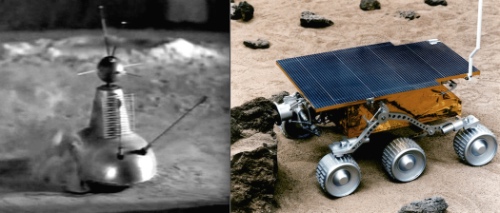
Special photo juxtapositions by Thomas Kent Miller; copyright © 2016-2017 by Thomas Kent Miller.
11. This German poster for the Soviet Union’s Mechte Navstrechu (1963) (refashioned in 1966 for the U.S. as Curtis Harrington’s Queen of Blood) focuses on the strength, courage and selflessness of a Soviet astronaut who is risking his life saving the life of an alien woman. Creative license places the planet Mars behind him when in fact, he steadfastly is struggling through a whirling red sandstorm on the surface of Mars.
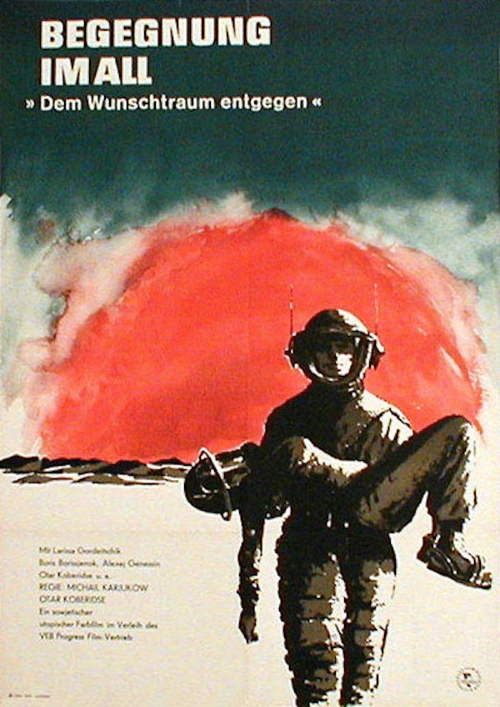
12. Battle Beyond the Sun (1963) began life in 1959 as a sophisticated space movie titled Nebo Zovyot (The Heavens Call) made by the USSR. Legendary B-movie producer and director Roger Corman bought U.S. rights to the film for a song, and handed it over to the novice filmmaker Francis Ford Coppola with instructions to re-edit it to make it palatable for American audiences. This shot is glimpsed in both versions, and it is for me the single most beautiful and evocative image of the planet Mars in all Mars science-fiction cinema.
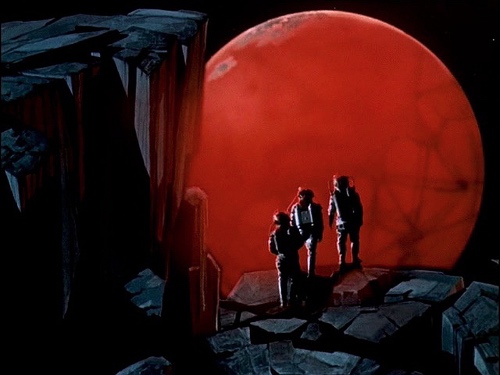
13. The Universal Pictures logo that graces the first few frames of Doom (2005) is a genuine work of art. Typically, the word “Universal” enters the screen from the right and begins to encircle what the camera pulling back reveals to be the planet Earth. In this case, however, the planet revealed is Mars! How cool is that? —Thomas Kent Miller
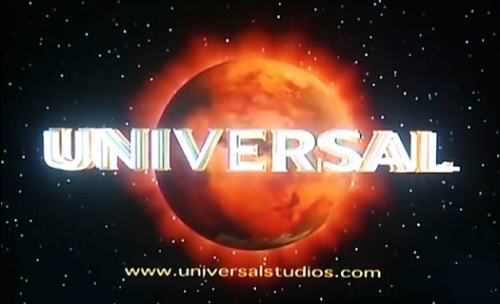

Incredible !!! I did not know there was a book on all these Mars Movies I loved as a child! I am going to order it now On Line. Are there pictures in the final Book I hope?
Hi Carl – The world needed a book like this, but nobody else was writing one, so I did. The book only came out in November…but the point of this list is that these particular graphics were left out of the book for one reason or another. The good news is that the book does contain 50+ pretty wonderful B&W graphics–some full-on spectacular. Thomas
My complements on a fine writeup and a fine book! I purchased a copy this weekend and have devoured it since.
“Fine” and “devour”—those are mighty nice words for an author to hear! Thanks much, M.P. Thomas